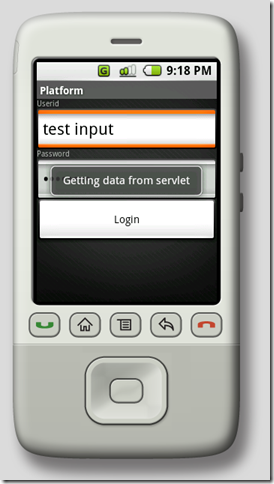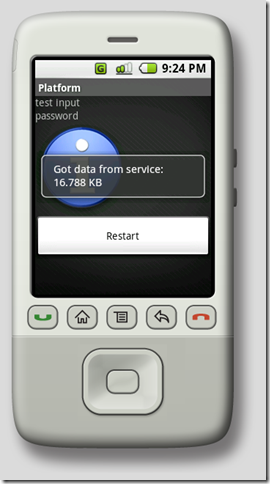Android - How to build a service-enabled Android app - Part 1/3 UI
Introduction #
I’ve written 3 tutorials to show you how to create a service enabled Android application that performs all of it’s network I/O in a background thread (not the UI thread). Please note that by service I mean web-service, not Android Service. These tutorials are split into three parts:
-
How to build a simple UI without using XML, by writing Java code to layout the UI.
Building the UI #
Most of the information I’ve read on Google’s Android documentation site, as well as other websites, take the approach of messing with XML to build an Android UI. Personally, I don’t like this approach; ideally, I would like a UI builder like JFormDesigner for Android, to generate the underlying UI code for me, whether it’s generated in Java or XML. The XML syntax is really cumbersome for me, and I’m really familiar with the Swing, so it’s natural for me to lay components out in Java code, and not XML. Having said that I will show you how to use a simple layout in Android for the purposes of creating a simple form based UI. It will have 2 screens:
-
a login screen that has a userid and password textfield, along with a button to login
-
a form screen that displays the userid, password, and a picture (that it gets from the service). It also has a button to restart the app.
I’m not going to delve into the lifecycle of an Android activity, and the various classes that exist in Android. Rather, I’m going to take the approach of showing you a sample app so that you can get your hands dirty. In future tutorials, I will go into greater detail on different parts of the Android API.
The code - login screen #
The main activity class is called NetworkActivity. It has some methods in it to create the UI screen described above. In this example, I’m using LinearLayout to create a simple form based UI. Here’s the code for the Activity:
public class NetworkActivity extends Activity {
// data
public EditText ttfUserid;
public EditText ttfPassword;
// constructor
/** Called when the activity is first created. */
@Override
public void onCreate(Bundle icicle) {
super.onCreate(icicle);
// create the panel to enclose everything
View mainPanel = _createInputForm();
// show the panel on the screen
setContentView(mainPanel);
}
...
}
This is what the first screen looks like:

Here’s the code for the first screen (created by _createInputForm()):
// input form
/** create the login form */
private ViewGroup _createInputForm() {
LinearLayout panel = new LinearLayout(this);
panel.setLayoutParams(
new LayoutParams(LayoutParams.WRAP_CONTENT, LayoutParams.WRAP_CONTENT));
panel.setOrientation(LinearLayout.VERTICAL);
// Userid : label and text field
TextView lblUserid = new TextView(this);
lblUserid.setText("Userid");
lblUserid.setTextSize(TypedValue.COMPLEX_UNIT_SP, 10f);
lblUserid.setLayoutParams(
new LayoutParams(LayoutParams.WRAP_CONTENT, LayoutParams.WRAP_CONTENT));
ttfUserid = new EditText(this);
ttfUserid.setLayoutParams(
new LayoutParams(LayoutParams.FILL_PARENT, LayoutParams.WRAP_CONTENT));
// ttfUserid.setText("a");
// Password : label and text field
TextView lblPassword = new TextView(this);
lblPassword.setTextSize(TypedValue.COMPLEX_UNIT_SP, 10f);
lblPassword.setText("Password");
lblPassword.setLayoutParams(
new LayoutParams(LayoutParams.WRAP_CONTENT, LayoutParams.WRAP_CONTENT));
ttfPassword = new EditText(this);
ttfPassword.setLayoutParams(
new LayoutParams(LayoutParams.FILL_PARENT, LayoutParams.WRAP_CONTENT));
ttfPassword.setTransformationMethod(new PasswordTransformationMethod());
// ttfPassword.setText("a");
// login button
final Button btnLogin = new Button(this);
btnLogin.setText("Login");
btnLogin.setLayoutParams(
new LayoutParams(LayoutParams.FILL_PARENT, LayoutParams.WRAP_CONTENT));
btnLogin.setGravity(Gravity.CENTER);
btnLogin.setOnClickListener(new View.OnClickListener() {
public void onClick(View view) {
new GetDataFromServlet().execute(NetworkActivity.this);
Log.i(getClass().getSimpleName(), "button was pressed");
}
});
// actually adding the views (that have layout set on them) to the panel
// userid
panel.addView(lblUserid);
panel.addView(ttfUserid);
// password
panel.addView(lblPassword);
panel.addView(ttfPassword);
// loginbutton
panel.addView(btnLogin);
return panel;
}
If you’re familiar with the XML code that would perform this layout, then you will find the layout params very familiar. Every widget that’s added to the LinearLayout has to have it’s layout params set. If you’re familiar with Swing, then the Activity is similar to a JFrame. The LinearLayout is like a JPanel with a LayoutManager already set. If you look at the code from this perspective, then it should start to seem more familiar. If you look at the XML code, it’s disorientating 😃.
UI builder and emulator performance #
One of the coolest Applets/Apps that I stumbled upon to help me make sense of the Android widget toolkit is DroidDraw. Try it out and you won’t be disappointed. It’s a simple GUI builder for Android that generates XML layouts; however, it will help you understand all the UI elements, even if you’re doing layout in Java.
I also stumbled upon this great article, that talks about how to determine how fast your emulator runs, so that you have some idea how fast your apps might run on a real device.
The code - form screen #
The second screen simply displays data that it gets from a service. More on this in the networking part of the tutorial.
This is what the second screen looks like:

Here’s the code for this screen:
// display user profile data callback
/** create a new panel to display the data and replace the existing content */
public void _displayUserProfile(Hashtable<DataKeys,
Serializable> up) {
String name = _getStringValue(up, DataKeys.str1, "user id");
String pwd = _getStringValue(up, DataKeys.str2, "password");
byte[] icon = _getByteRayValue(up, DataKeys.img1, null);
View infoPanel = _createInfoPanel(name, pwd, icon);
setContentView(infoPanel);
}
private View _createInfoPanel(String uid,
String pwd,
byte[] icon) {
LinearLayout panel = new LinearLayout(this);
panel.setLayoutParams(
new LayoutParams(LayoutParams.FILL_PARENT, LayoutParams.FILL_PARENT));
panel.setOrientation(LinearLayout.VERTICAL);
// user id
TextView lblName = new TextView(this);
lblName.setText(uid);
lblName.setTextSize(TypedValue.COMPLEX_UNIT_SP, 14f);
lblName.setLayoutParams(
new LayoutParams(LayoutParams.WRAP_CONTENT, LayoutParams.WRAP_CONTENT));
// password
TextView lblEmail = new TextView(this);
lblEmail.setText(pwd);
lblEmail.setTextSize(TypedValue.COMPLEX_UNIT_SP, 14f);
lblEmail.setLayoutParams(
new LayoutParams(LayoutParams.WRAP_CONTENT, LayoutParams.WRAP_CONTENT));
// icon
Bitmap bitmap = BitmapFactory.decodeStream(new ByteBuffer(icon).getInputStream());
ImageView lblIcon = new ImageView(this);
lblIcon.setImageBitmap(bitmap);
lblIcon.setLayoutParams(
new LayoutParams(LayoutParams.WRAP_CONTENT, LayoutParams.WRAP_CONTENT));
// quit button
final Button btnRestart = new Button(this);
btnRestart.setText("Restart");
btnRestart.setLayoutParams(
new LayoutParams(LayoutParams.FILL_PARENT, LayoutParams.WRAP_CONTENT));
btnRestart.setGravity(Gravity.CENTER);
btnRestart.setOnClickListener(new View.OnClickListener() {
public void onClick(View view) {
setContentView(_createInputForm());
Log.i(getClass().getSimpleName(), "restart button was pressed");
}
});
// actually adding the views (that have layout set on them)
// to the panel name
panel.addView(lblName);
panel.addView(lblEmail);
panel.addView(lblIcon);
panel.addView(btnRestart);
ScrollView scrollPanel = new ScrollView(this);
scrollPanel.setLayoutParams(
new LayoutParams(LayoutParams.FILL_PARENT, LayoutParams.FILL_PARENT));
scrollPanel.addView(panel);
return scrollPanel;
}
This screen is very similar to the first one. The only interesting thing going on here is the creation of a Bitmap widget. A PNG file is actually loaded from a service, serialized as byte[] and sent to the app, which then has to display it in a widget. The PNG file’s bytes can be loaded directly into the Bitmap widget and it will show the image on screen. The image is actually loaded from a JAR file included in the servlet that’s included in the source code. More on this will be covered in the networking file tutorial.
Download source code #
To download the source code for this tutorial, click here. There are 3 folders in this zip file:
-
AndroidTest – This contains the Android UI and web service client code
-
ServiceTest – This contains the web service, or servlet code
-
SharedTest – This contains the code that is shared between the Android code and web service code.
👀 Watch Rust 🦀 live coding videos on our YouTube Channel.
📦 Install our useful Rust command line apps usingcargo install r3bl-cmdr(they are from the r3bl-open-core project):
- 🐱
giti: run interactive git commands with confidence in your terminal- 🦜
edi: edit Markdown with style in your terminalgiti in action
edi in action
